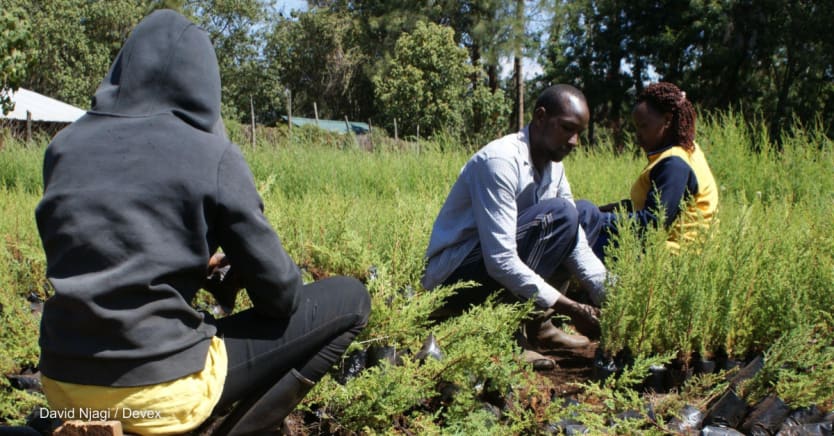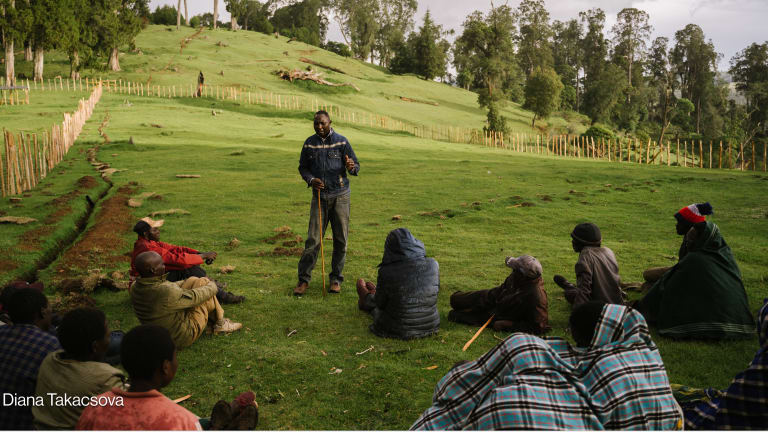
The United Nations has deemed the 2021-2030 period as its “Decade on Ecosystem Restoration.” Resolutions from the U.N. Environment Assembly, which concluded last week in Nairobi, Kenya, seem to reflect the same focus as they “prioritize ecosystem restoration, biodiversity protection, resource efficiency, consumption and production patterns, climate mitigation and adaptation, job creation and poverty reduction.”
But in central Kenya, one group of farmers had made a conservation resolution of their own before the U.N. event even kicked off.
Remote weather stations give Kenyan farmers an edge in bee farming
Remote weather stations in southern Kenya's Maasai Maara area are providing farmers with data to predict weather patterns and sustain their bee colonies.
The farmers spoke in low tones as they cleared patches of vegetation inside the Aberdare Forest. The section where they worked is the size of two football fields, but it has been deforested due to frequent fires sparked by honey poachers, who use smoke to scare bees away from their hives. The farmers were planting knee-high saplings, which will grow into restored tree coverage within the next decade.
This simple process will improve the forest's ability to absorb and store water, which it then releases into rivers and lakes in measured rations, saving millions of Kenyans from so-called water stress, according to Victor Kabutbei, a forest manager at North Kinangop Forest Station, which is part of the vast Aberdare Forest.
“Communities are seeing direct benefits in terms of water easement and a source of pasture for livestock when there is prolonged drought. Women can also collect firewood from the forest to use as cooking fuel,” Kabutbei said.
Aberdare Forest, which covers an area of about 103,300 hectares (255,300 acres), is one of Kenya’s five major “water towers,” an area that can absorb and store water naturally, and which provide an estimated 75% of the country’s water resources serving millions of Kenyans living in both upstream and downstream communities. The Aberdare Mountains, where the Aberdare Forest Reserve is located, is a UNESCO World Heritage Site and home to small and large animals such as elephants, buffaloes, lions, and leopards.
Over the years, however, it has been facing increased deforestation and degradation due to forest fires, illegal logging, poaching, and soil erosion. This has worsened water stress, especially for pastoralists and other lowland communities, Kabutbei said.
For instance, the forest “recharges” central Kenya’s Lake Olbolosat — the source of Ewaso Nyiro River, the main supplier of freshwater in the country’s northeast — by supplying it with stored water through ground seepage. The river stretches from its source and flows all the way to the Lorian Swamp near the Kenya-Somalia border to the east, Kabutbei said.
Paul Learpanai, a pastoralist living in the Archers Post settlement in northeastern Kenya, said he has witnessed the Ewaso Nyiro River decline from a giant that flowed over a 15-foot-high bridge in his village to a stream that locals can easily cross on foot.
“This is something they could not dare do during the river’s high season for fear of being swept away,” he said. “I feel very scared. If this river disappears, we might all die.”
The river has shrunk to such low levels due to a combination of water extraction from the lake, property development, and worsening climate change, said Ibrahim Kabelo, a program officer at Merti Integrated Development Programme, a local NGO working in northeastern Kenya.
Kabelo and his team at MIDP have traced the pressure that the river is facing from its source in central Kenya and followed it through nine counties in central and northeastern Kenya that the river reaches.
Their investigation found that horticultural farms at Lake Olbolosat extract huge volumes of water to grow fresh produce.
Kenyan farmers use water harvesting to counter climate change effects
Working with development organizations, farmers are tapping stormwater runoff from nearby roads and directing it into basins and ponds for later use.
Property development in towns where the river passes through has also led to demand for building materials like timber and sand, while charcoal serves the growing population with cooking fuel.
This has led to many trees being cut down in Aberdare Forest, including immature ones that have not reached the harvesting age of 18 to 28 years.
“Severe sand harvesting in three counties — both upstream and downstream — are also responsible for the river’s reduced water flow,” said Kabelo. Sand harvesting significantly impacts a river’s capacity to retain water.
According to Wamiti Wanyoike, a researcher at the National Museums of Kenya, water extraction leads to smaller volumes reaching communities living on the downstream end of the river. Logging, on the other hand, reduces a forest’s ability to recharge the freshwater source.

“Both the river and the lake are threatened. I feel there is a sjense of urgency to prevent further pressure on these water resources and the consequences of this misuse in the near future,” Wanyoike said.
This was why Learpanai appeared visibly upset when speaking to Devex. Learpanai is from the Borana tribe. But during the 30 years that he has lived in the Archers Post settlement, he has seen the river support other tribes in northeastern Kenya, such as the Samburu, Turkana, and Rendille.
“When there is plenty of water available for everyone, there is peace. But when there is little available, conflict over water often escalates among pastoralist communities and crop farmers due to competition,” Learpanai said.
One way the river is being conserved is through educating both upstream and downstream communities about the importance of the Ewaso Nyiro River to the stability of northeastern Kenya.
Molu Tepo, a program manager at MIDP, said the organization does this through annual camel caravans or rides along the river, which began in 2014 and aim to promote peace among downstream and upstream communities. Another way is by lobbying upstream communities to conserve the river’s source and support system in the Aberdare Basin.
Solar predator lights reducing human-wildlife conflict in Kenya
Conservationists are using solar-powered predator lights, which absorb energy during the day and switch on automatically at night, to scare away invading wildlife and reduce human-wildlife conflict.
Working with WWF-Kenya, communities are restoring degraded sections of Aberdare Forest through tree planting and plantation establishment, according to Peter Muriuki Murage, the chairman of North Kinangop Community Forest Association.
Murage said farmers have managed to restore about 100 hectares of degraded sections with over 40,000 saplings.
Community forest associations, in collaboration with WWF-Kenya, have also rolled out programs to educate locals on how to harvest honey without using fire to get rid of the bees.
“Farmers are trained to wear special clothing for harvesting honey. But if they have to do it the traditional way, they are advised to carry water along for dousing the burning embers after harvesting,” Murage said.
Caroline Njiru, the WWF-Kenya coordinator for Naivasha landscape, said the Aberdare Forest Landscape Restoration Project is part of the African Forest Landscape Restoration Initiative, which aims to restore 100 million hectares of degraded land on the continent by 2030.
With funding from Germany’s Federal Ministry for Economic Cooperation and Development for a five-year effort, the landscape restoration project aims to restore 500 hectares with mixed forests, 100 hectares as farmland, and 40 kilometers of riparian land, she said.


